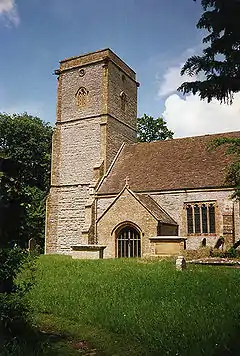St Mary's Church, Limington
The Church of Saint Mary in Limington, Somerset, England dates from the late 14th century and includes fragments of an earlier building. It has been designated as a Grade I listed building.[1]
| Church of Saint Mary | |
|---|---|
 | |
| Location | Limington, Somerset, England |
| Coordinates | 50°59′50″N 2°39′12″W |
| Built | 14th century |
Listed Building – Grade I | |
| Designated | 19 April 1961[1] |
| Reference no. | 262636 |
 Location of Church of Saint Mary in Somerset | |
Fragments of the north door and tower date from the Norman period, but most of the building are from the 14th century with the north chapel being dated to 1328.[2] It is built of local stone with Hamstone dressings. The tower has six bells, the oldest of which is from the 15th century. The interior includes a pulpit and altar table from the 17th century and an octagonal font from the 16th. There are several effigies including one of Sir Richard Gyvernay who built the chantry chapel and died in 1329.[1] Below this is a smaller female figure and there is also a double monument of a male and female figure, which are believed to be Henry and Matilda Power and date from the 1340s.[3]
The earliest known rector is Thomas Wolsey who held the living between 1500 and 1509,[1] before becoming a cardinal of the Roman Catholic Church.
The Anglican parish is part of the benefice of Ilchester with Northover, Limington Yeovilton and Podimore within the archdeaconry of Wells.[4]
See also
References
- "Church of Saint Mary". historicengland.org.uk. English Heritage. Retrieved 2008-10-12.
- Dunning, Robert (2007). Somerset Churches and Chapels: Building Repair and Restoration. Halsgrove. p. 38. ISBN 978-1841145921.
- Dressler, Rachel (September 2008). "Gender as Spectacle and Construct: The Gyvernay Effigies at St. Mary's Church, Limington" (PDF). Different Visions: A Journal of New Perspectives on Medieval Art (1). ISSN 1935-5009. Retrieved 26 October 2012.
- "The Blessed Virgin Mary, Limington". Church of England. Retrieved 29 October 2012.